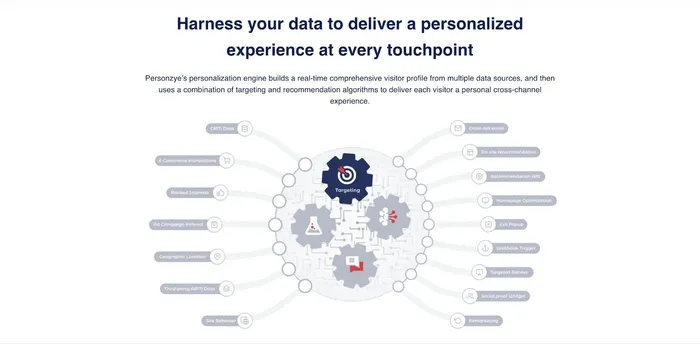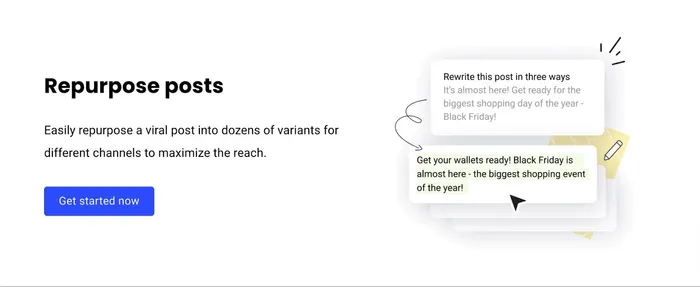Marketing
How AI Helps in Content Distribution: 5 Effective Ways
Ekta Swarnkar
5/22/2024
9 min read
TABLE OF CONTENTS
5 ways AI can optimize your content distribution strategy
Optimize your content distribution strategy with AI
 Regardless of the effort you put into content creation, your work might not see the light of the next day without a content distribution strategy.
Regardless of the effort you put into content creation, your work might not see the light of the next day without a content distribution strategy.
With competition increasing and the market getting saturated with content, hoping to rank on Google is no longer enough. You need a content distribution plan.
But we’re already busy creating content. Distributing content will take longer, and we’re also promoting published blog posts on social media.
Promoting blog posts on social media doesn’t help you drive long-term traffic. People can see right through your posts — they can determine whether you want to add value or merely drive a click.
And you don’t have to distribute your content manually — use AI to automate tasks, generate insights, and review analytics to optimize your content operations. Wondering how?
This post lists different ways AI helps in content distribution. Use this list to shape your content distribution strategy and increase your content's results and lifetime value.
5 ways AI can optimize your content distribution strategy
Content distribution isn’t promoting blog posts on social media. It’s about choosing the right content formats to promote it and attract your audience. You have to find ways to deliver information most easily and attractively.
So, how do you identify the most resonating content formats? How do you analyze which posts are worth the effort?
According to a report by Kibo Commerce, marketers saw a 70% increase in ROI after implementing AI in their content marketing. By using AI to monitor the content performance of different marketing channels, brands can generate positive ROI.
Here are some of the ways you can do the same:
#1. Content personalization
Customers expect brands to personalize their experiences. But without AI, marketers have always struggled to personalize individual customer experiences at scale. Not only was it time-consuming, but also unscalable.
AI solved the personalization problem. Companies employed AI in various parts of marketing to optimize the experiences customers get with their brands:
User profiling: AI tools analyze user data such as browsing history, social media activity, and search queries to understand and differentiate users. AI analyzes customer behavior 24/7 to create user profiles and segment them into different target segments.
Personalized advertising: By regularly tracking user engagement, interaction, and keywords, AI helps you personalize users' ad experiences to increase sales.
Natural Language Processing (NLP:) AI tracks and captures terms and keywords users use during online interactions (such as reviews, comments, etc.) to understand sentiment so you can use them in your marketing campaigns or media assets and make them more resonating.
Tools like Personyze use AI and NLP to help you enrich your customer profiles by collecting information from multiple data sources like browsing, social media activity, and purchases. Then, it uses a combination of targeting and algorithm recommendations to provide a unified multi-channel experience to your customers.

#2. Content optimization
Content plays a major role in converting website visitors into customers. Therefore, you must make sure your company's content is optimized for your target audience so they can connect.
AI helps in optimizing content for different audience segments using the following methods:
Analyzing audience content consumption: Using NLP, AI analyzes audience content consumption to identify its preferred style in terms of readability, tone, content format, and language use. This information allows you to optimize your content to increase its effectiveness.
A/B split testing: AI tools can automatically conduct A/B tests to find better versions and optimize your marketing assets to resonate with more customers.
Scheduling content for optimal times: Just like identifying which content formats get the most engagement, AI can also identify when most of your target audience is active. By sharing your content at optimal times, you increase its engagement and the chances of being discovered by identical audiences.
Unbounce's Smart Traffic uses AI to automatically run A/B tests on different versions, analyzing real-time performance data. This way, it keeps optimizing traffic distribution to direct visitors toward the versions that convert the best.

#3. Content curation
Brands that could produce lots of quality content get more visibility than brands that don’t. According to a report by the Content Marketing Institute, 58% of B2B marketers saw an increase in sales and revenue because of content marketing in 2023.
However, producing content at scale has always been a problem. Some brands used AI to mass-produce content to solve this problem, but the outcome was poor, fluff content that added no value.
Soon enough, marketers realized that’s not how you use AI to produce content. You use it to curate content based on personalized recommendations to engage the target audience. Here are some ways to use AI to curate content:
Automated content discovery: AI algorithms monitor data from websites, social media, databases, and other online sources to identify relevant and high-quality content. Using NLP and machine learning, AI can understand content's context, topics, and relevance to find the most valuable pieces for curation.
Content curation for individuals: AI can analyze users' interests, preferences, and consumption patterns by examining their browsing history, search queries, social media activity, and other data sources. AI personalizes content tailored to their unique needs and interests by building user profiles and curating a highly relevant and engaging content experience.
Mutiny also works on the same model. It’s an AI-powered content generation platform that automatically generates on-brand website copy drafts based on your inputs and audience data. What do you get? Conversion-focused microsites personalized for individual users.
#4. Content repurposing
Promoting your blog posts on social media for the sake of promoting is a recipe for failure. That's not how it works — if you share a few lines about your blog with the post link, nobody will bat an eye. To get your audience's attention, you must give them information in a way they like.
Enter content repurposing.
The good news is that you don't have to promote the blog post just as the blog post. It can be turned into engaging content with these formats:
Carousels
Images
Podcasts
Reels (short videos)
Infographics
Expert quotes
Text blurbs
The best part? You can use one blog post to create multiple content assets to add to your content marketing strategy.
Think about it: A blog post as a link can only be promoted once. However, with content repurposing, you could promote the same blog post multiple times with a different idea.
Isn't that amazing?
It is. All that sounds great, but creating these media assets will take time. How can we use AI to repurpose blog posts into different marketing assets?
Glad you asked.
Social media marketing tools like Buffer enable marketers to repurpose content using AI. Buffer allows users to rewrite social media posts with a few clicks.

For example, if you give it a text copy, it can be rephrased, shortened, or expanded on ideas. It can also generate new ideas to publish on social media, so use it to produce copy and convert it into various marketing assets to be shared multiple times.
#5. Content monitoring
Finally, AI also helps brands monitor content effectiveness to double down on what’s working and disqualify what’s not. Here are different ways to use AI in monitoring content performance:
Competitive analysis: AI tools monitor content and conversations around competitors to identify trends and insights into their strategies, campaigns, and customer sentiment. By figuring out what’s working for your competitors, you can also use those strategies to get a portion of their benefits.
Influencer and trend tracking: AI tools help brands identify influential voices and industry trends. By monitoring these influencers and trends, brands can use these topics to reach a larger audience and build a memorable brand experience.
Send automated alerts: Some AI tools allow brands to send automated real-time alerts when specific keywords, topics, or sentiments are triggered. This gives marketers enough time to respond quickly to high-priority situations.
Awario is a monitoring tool for competitors' online presence. It tracks brand/product mentions to analyze the sentiment of competitors’ audiences, identify trending topics, and determine their social strategies.

Optimize your content distribution strategy with AI
The more you use AI in your content operations, the more accurate outcomes you’ll get. To optimize your content distribution strategy with AI, follow these strategies:
Personalize through user profiling and tailored experiences
Optimize using automated A/B testing and performance analysis
Curate relevant and high-quality content
Repurpose marketing assets across multiple formats
Monitor metrics, competitor strategies, and emerging trends
These AI-powered tactics can optimize your reach, engagement, and ROI. And while these are effective strategies, the use cases of AI are endless. That’s why we recommend you test different tools and find out more ways to optimize your content processes using AI.













